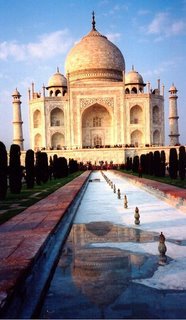
Check out the LINK below AFTER reading this......
Real History of "Taj Mahal"
"The Moghul Emperor Shah Jahan in the memory of his wife Mumtaz Mahal built the Taj Mahal. It was built in 22 years (1631 to 1653) by 20,000 artisans brought to India from all over the world!. Many people believe Ustad Isa of Iran designed it." This is what your guide probably told you if you ever visited the Taj Mahal. This is the same story I read in my history book as a student.
NOW READ THIS.......
No one has ever challenged it except Prof. P. N. Oak, who believes the whole world has been duped. In his book Taj Mahal:
The True Story, Oak says the Taj Mahal is not Queen Mumtaz's tomb but an ancient Hindu temple palace of Lord Shiva (then known as Tejo Mahalaya). In the course of his research Oak discovered that the Shiva temple palace was usurped by Shah Jahan from then Maharaja of Jaipur, Jai Singh.In his own court chronicle, Badshahnama, Shah Jahan admits that an exceptionally beautiful grand mansion in Agra was taken from Jai SIngh for Mumtaz's burial.
The ex-Maharaja of Jaipur still retains in his secret collection two orders from Shah Jahan for surrendering the Taj building. Using captured temples and mansions, as a burial place ! for dead courtiers and royalty was a common practice among Muslim rulers.
For example, Humayun,Akbar, Etmud-ud-Daula and Safdarjung are all buried in such mansions. Oak's
inquiries began with the name of Taj Mahal. He says the term "Mahal" has never been used for a building in
any Muslim countries from Afghanisthan to Algeria. "The unusual explanation that the term Taj Mahal
derives from Mumtaz Mahal was an illogical in atleast two aspects.
Firstly, her name was never Mumtaz Mahal but Mumtaz-ul-Zamani," he writes.
Secondly, one cannot omit the first three letters 'Mum' from a woman's name to derive the remainder as the name for the building."Taj Mahal,he claims, is a corrupt version of Tejo Mahalaya, or Lord Shiva's Palace.
Oak also says the love story of Mumtaz and Shah Jahan is a fairy tale created by court sycophants, blundering historians and sloppy archaeologists. Not a single royal chronicle of Shah Jahan's
time corroborates the love story. Furthermore, Oak cites several documents suggesting the Taj Mahal predates Shah Jahan's era, and was a temple dedicated to Shiva, worshipped by Rajputs of Agra city.
For example,
Prof. Marvin Miller of New York took a few samples from the riverside doorway of the Taj. Carbon dating tests revealed that the door was 300 years older than Shah Jahan.
European traveler Johan Albert Mandelslo,who visited Agra in 1638 (only seven years after Mumtaz's death), describes the life of the city in his memoirs.But he makes no reference to the Taj Mahal being built.
The writings of Peter Mundy,an English visitor to Agra within a year of Mumtaz's death, also suggest the Taj was a noteworthy building well before Shah Jahan's time.
Prof. Oak points out a number of design and architectural inconsistencies that support the belief of the Taj Mahal being a typical Hindu temple rather than a mausoleum.Many rooms in the Taj !Mahal have remained sealed since
Shah Jahan's time and are still inaccessible to the public. Oak asserts they contain a headless statue of Lord Shiva and other objects commonly used for worship rituals in Hindu temples.
Fearing politicalbacklash,Indira Gandhi's government tried to have Prof. Oak's book withdrawn from the bookstores, and hreatened the Indian publisher of the first edition dire consequences. There is only one way to discredit or validate Oak's research.
The current government should open the sealed rooms of the Taj Mahal under U.N. supervision, and let international experts investigate.
Do circulate this to all you know and let them know about this reality.
The below link adds as a visual proof to what is described above.
http://www.stephen-knapp.com/was_the_taj_mahal_a_vedic_temple.htm